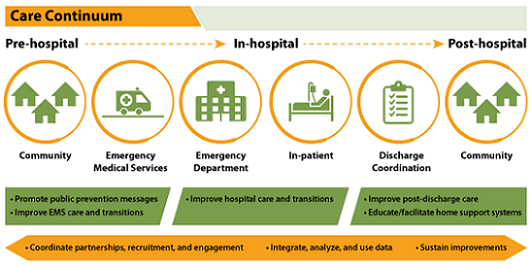About the Coverdell Program
On this Page
Time Lost is Brain Lost

Partners in the Coverdell program build strong, coordinated stroke systems in their communities. They benefit from collaboration and support with local, regional, and national resources that improve patient care and save lives.
“We took advantage of the extra resources provided by Coverdell. Being a small institution means a smaller budget and fewer staff. We aren’t a large research facility, but we were able to partner with one to achieve improvements through networking and virtual consults.”
—Brenda Williams, RN, MSN, Beloit Health System, Beloit, WI, a partner of the Wisconsin Coverdell Program.
The Paul Coverdell National Acute Stroke Program (PCNASP) creates a culture that connects health care professionals—across the system of care—to improve stroke care and save lives.
Learn more about the Coverdell program’s stroke systems of care, and its mission, goals, and history.
Overview

Stroke systems of care improve care and support for stroke patients throughout their health care journey—from the first symptoms of stroke through the transition from Emergency Medical Services (EMS) to hospital care and from rehabilitation to follow up with primary care physicians to prevent complications and second strokes. EMS agencies, hospitals, and health care facilities collect and analyze data about stroke patients and care. They share best practices and data and work to improve patient care.
The Coverdell program partnered with the Joint Commission and the American Heart/Stroke Associations to develop and release stroke performance measures. In addition, the CDC and American Heart Association (AHA) implemented a Memorandum of Understanding to improve the quality of care for stroke patients across multiple settings. Learn more about this Collaboration.
These ongoing partnerships continue mutual efforts to measure alignment and improve stroke care across care settings.
Mission
The mission of the Coverdell program is—
- Measure, track, and improve the quality of care and access to care for stroke patients from onset of stroke symptoms through rehabilitation and recovery.
- Decrease the rate of premature death and disability from stroke.
- Eliminate disparities in stroke care.
- Support the implementation of comprehensive stroke systems across the continuum of care.
- Improve access to rehabilitation and opportunities for recovery after stroke.
- Increase the workforce capacity and scientific knowledge of stroke care within stroke systems of care.
Goals
The near-term goals of the Coverdell program are to—
- Encourage the development of statewide systems of care for stroke patients through coordination with emergency medical services and collaboration among statewide partners.
- Communicate with major stakeholders in stroke care to ensure ongoing improvement in the quality of that care.
The long-term goal of PCNASP is to ensure that all Americans receive the highest quality of acute stroke care currently available and to reduce the number of untimely deaths attributable to stroke, prevent stroke-related disability, and prevent stroke patients from suffering recurrent strokes.
Publications and Resources
Journal Articles
- George MG, Tong X, Yoon PW. Use of a registry to improve acute stroke care—seven states, 2005–2009. MMWR. 2011;60(07);206-210.
- George MG, Tong X, McGruder H, et al. Paul Coverdell National Acute Stroke Registry surveillance—four states, 2005–2007. MMWR. 2009;58(SS07);1-23.
- Frankel M, Hinchey J, Schwamm LH, et al. Pre-hospital and hospital delays after stroke onset—United States, 2005–2006. MMWR. 2007;56(19):474-478.
- Labarthe DR, Broderick JP, Atkins D, Zheng ZJ, Yoon SS. Paul Coverdell National Acute Stroke Registry Prototypes: assessing acute stroke care in the U.S. and beyond. American Journal of Preventive Medicine. 2006;31:(6S2)
Program Publications
- Paul Coverdell National Acute Stroke Registry Program: Summary Report 2007–2012 [PDF-959K]
- Paul Coverdell National Acute Stroke Program—Strategies from the Field [PDF-457K]
Resources
- Vital Signs: Preventing Stroke Deaths
- CDC Stroke Patient Education Handouts
- CDC Stroke Educational Materials for Health Professionals
- NINDS Common Data Elements for Stroke
- American Heart Association
- American Stroke Association
- National Stroke Association
Reference
- Adapted from LH Schwamm, et al. Recommendations for the Establishment of Stroke Systems of Care: Recommendations from the American Stroke Association’s Task Force on the Development of Stroke Systems. Stroke. 2005;36:690-703.
- Page last reviewed: September 5, 2017
- Page last updated: September 5, 2017
- Content source:



 ShareCompartir
ShareCompartir